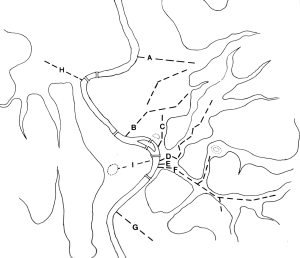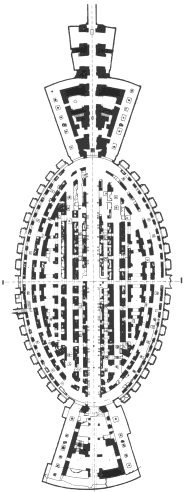The Greeks are famous for their brains; the Romans for their drains
In the Colosseum,
rainwater was collected in the cavea by concentric ducts and poured into vertical pipes leading to the ground floor. From there the water flowed partly towards the arena and partly towards the outside, because of a double incline of the floor. On the outside of the building, water (including that of the surrounding square) was drained into a brick conduit (60 cm wide and 160 cm deep) which surrounds the Colosseum 2 metres below ground at the bottom of the first step at the base (see image below).

At regular intervals along this drain there are wells that reach 8 metres deep, down to a much bigger drain that also surrounds the amphitheatre. This drain was probably connected to the main sewer, which passes along Via di S. Gregorio, turns right under the Circus Maximus and reaches the Tiber river near the church of Santa Maria in Cosmedin, where also is the famous “Bocca della verità “.
The internal water from the cavea and the arena was collected by an elliptical drain all along the side of the arena, and from there it flowed into the big conduits placed under the four main entrances. One would think that these four collectors would carry the water to the big elliptical drain placed 8 metres deep around the monument, but recent studies have demonstrated that outgoing water was drained only by the southern main axis collector, since it appears that the other three drains are not connected to the internal elliptical collector.

It is not clear, therefore, if all four drains are connected to this external one. As far as we know these drains were built at the same time as the foundations by casting the cement over wooden boxing more than 50 metres long. The floor of these conduits – made in Domitian’s time – was paved with bricks and it was carefully sloped in order to have the right incline. The huge dimension of these conduits has led some (Mocchegiani) to think that they had been planned, from the beginning of the construction, to carry the enormous quantity of water necessary to fill up the arena for the naumachiae, and that later, in Domitian’s time, this project may have been abandoned. This could explain why ancient authors wrote about naumachiae held in the Colosseum. If we believe that the amphitheatre built by Titus was completed by his brother Domitian, then some small-size naumachia may have been organized in Titus’ time; later, with the excavation of the arena, it would have become impossible.
It is common sense to think that so many people, gathered under the sun for so many hours, needed some refreshment, and indeed some tracks on the walls on different floors have been interpreted as tracks for pipes of drinking fountains. Recent studies (Lombardi and Corazza) have found evidence of fountains in the Colosseum, probably twenty on the ground floor, sixteen on the second floor beside the stairs, forty in the gallery between the second and third floor and seventy on the third floor. There are doubts, however, about the function of many conduits of the amphitheatre. Some (Luciani) suggest that the pipes and ducts placed here and there may be leader pipes, i.e. they carried water inside, not outside.

The drains on the shorter axis were excavated between 1974 and 1980 by the then Director of the monument, Claudio Mocchegiani Carpano. The sediments were analysed by Professors Devoto and Parotto. Predictably, in the silt they found remains dating back to the IV-V century, i.e. the time in which the conduits got clogged up.
There were small bones of animals (chickens, sheep, pigs, goats), both exotic and domestic, probably destined to be eaten by the spectators or by the staff of the amphitheatre. It is therefore believed that bigger bones were recycled in order to craft objects. They also found many fruit piths and seeds, well preserved in the silt. We know from this finding that the Romans while watching the shows ate figs, olives, nuts, peaches and melons. Luciani (Il Colosseo) observes that it is all summer fruit, which leads to think that the shows were generally held during the good season. In the drains were also found pieces of pottery, mainly oil lamps, and even a tabella defixionum, a kind of thin plate used for sorcery.

All the images on this page have been reproduced from Roma Sotterranea, by Roberto Luciani, Palombi, 1985
